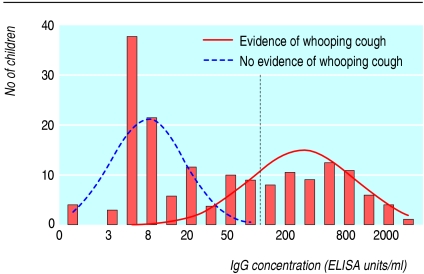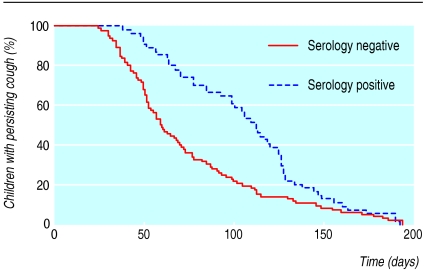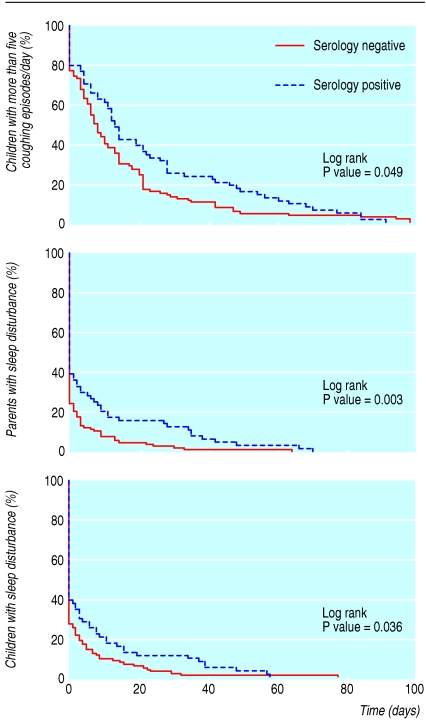Abstract
Objective To estimate the proportion of school age children with a persistent cough who have evidence of a recent Bordetella pertussis infection.
Design Prospective cohort study (October 2001 to March 2005).
Setting General practices in Oxfordshire, England.
Participants 172 children aged 5-16 years who presented to their general practitioner with a cough lasting 14 days or more who consented to have a blood test.
Main outcome measures Serological evidence of a recent Bordetella pertussis infection; symptoms at presentation; duration and severity of cough; sleep disturbance (parents and child).
Results 64 (37.2%, 95% confidence interval 30.0% to 44.4%) children had serological evidence of a recent Bordetella pertussis infection; 55 (85.9%) of these children had been fully immunised. At presentation, children with whooping cough were more likely than others to have whooping (odds ratio 2.85, 95% confidence interval 1.39 to 5.82), vomiting (4.35, 2.04 to 9.25), and sputum production (2.39, 1.14 to 5.02). Children with whooping cough were also more likely to still be coughing two months after the start of their illness (85% v 48%; P = 0.001), continue to have more than five coughing episodes a day (P = 0.049), and cause sleep disturbance for their parents (P = 0.003).
Conclusions For school age children presenting to primary care with a cough lasting two weeks or more, a diagnosis of whooping cough should be considered even if the child has been immunised. Making a secure diagnosis of whooping cough may prevent inappropriate investigations and treatment.
Introduction
School age children with a persistent cough present general practitioners with diagnostic and management dilemmas. A precise diagnosis is often difficult for the doctor, but parents are anxious for an explanation. Children commonly receive empirical treatment for asthma and may be referred for further investigation.1 These investigations often fail to yield a clinical reason for the cough, which can last for months.
Studies in the United States report a 20% incidence of Bordetella pertussis infection among adults with a persistent cough.2 Despite data showing that neither infection nor immunisation results in lifelong immunity, whooping cough is seldom diagnosed in primary care because of the lack of specificity of clinical symptoms and signs. Whooping cough is perceived as a disease of very young children who have not been immunised and who have classic features such as whoop. Notifications among older children in England and Wales have been low for several years.3
We aimed to estimate the community prevalence of whooping cough among a population of children who presented to primary care with persistent cough and to describe associated clinical features and duration of cough.
Methods
Participants
Between October 2001 and March 2005 we prospectively recruited 179 children aged 5 to 16 years inclusive who had been coughing for 14 days or more. General practitioners from 18 practices in Oxfordshire identified children during the consultation and referred them to study nurses. Each child was seen by a study nurse either at the practice or in the child's home. We excluded seven children because we failed to obtain consent to take blood.
Data collection
We recorded a detailed cough history at presentation: duration of cough; presence of coughing spasms, whoop, post-cough vomiting, apnoea, sputum production, wheeze, and exercise limitation; and history of cough in household members. We asked parents for details of their child's immunisations and verified any information they gave from the parent held record or medical notes. After recruitment, we asked parents and children to complete a daily cough diary for two weeks and then a weekly diary for the duration of the cough.
Serological diagnosis
We took a blood sample at presentation for all children and sent it to the Respiratory and Systemic Infection Laboratory of the Health Protection Agency Centre for Infections in Colindale, London for estimation of IgG titres to pertussis toxin. For children who had been coughing for between 14 and 28 days at presentation, we sought consent to take a second blood sample four to six weeks after the initial sample. We made a diagnosis of a recent Bordetella pertussis infection if we found a fourfold change in IgG antibody titre to pertussis toxin in paired samples or a single IgG titre to pertussis toxin that was greater than 100 ELISA units/ml.4 We informed participating practices of all individual serology results.
Sample size and statistical analysis
Our original target was to recruit a minimum of 50 cases of whooping cough in order to achieve adequate precision (±5% with a whooping cough prevalence of 20%). In fact, we recruited 64 cases. We used logistic regression to obtain adjusted odds ratios for the symptoms recorded at presentation. We plotted the serological data on a logarithmic scale and fitted a mixture of two normal distributions (fig 1). We obtained the parameters for the Gaussian curves by using a mixture of two normal components to model the IgG antibody titre (log base 10) to pertussis toxin by minimising its log-likelihood function. The duration and severity of cough and sleep disturbance are presented as Kaplan-Meier plots. We tested the significance of the difference between children according to serology by using the log rank statistic.
Fig 1.
IgG antibody titre to pertussis toxin. The black line indicates the 100 ELISA units/ml IgG concentration used as cut-off point for a positive diagnosis
Results
We estimated from practice audit that we recruited 62% (179/289) of eligible children into our study; 172 (96%) recruited children consented to give a blood sample. Sixty four (37.2%, 95% confidence interval 30.0% to 44.4%) of these children had serological evidence of a recent Bordetella pertussis infection.
No differences in age and sex between children with positive and negative serology existed at presentation, but those with positive serology were more likely to have whooping, vomiting, and sputum production and less likely to wheeze (table). The mean duration of cough at presentation was 45 days for children with positive serology and 44 days for those with negative serology. However, the total duration of cough was greater for children with positive serology (median 112 days, range 38 to 191) than for those with negative serology (median 58 days, range 24 to 192). Two months after the start of their symptoms, 85% (46/54) of children with positive serology were still coughing compared with 49% (45/92) of those with negative serology (P = 0.001) (fig 2). After recruitment, differences existed between the two groups in the severity of cough and the impact of the illness on the child's and parents' sleep (fig 3). No differences existed in the numbers of days off school or parents taking time off work.
Table 1.
Symptoms at presentation and demographic, personal, and family characteristics by serology results for Bordetella pertussis among 172 children with persistent cough (≥14 days). Values are numbers (percentages) unless stated otherwise
|
Serology*
|
Odds ratio (95% CI)
|
|||
|---|---|---|---|---|
| Characteristic | Positive (n=64) | Negative (n=108) | Crude | Adjusted† |
| Demographic | ||||
| Mean (range) age (years) | 9.8 (5 to 16.8) | 9.1 (5 to 16.9) | - | - |
| Male sex | 36 (56.3) | 58 (53.7) | 1.11 (0.60 to 2.06) | - |
| Personal | ||||
| Immunisation‡ | 55 (85.9) | 104 (97.2) | 0.18 (0.05 to 0.68) | - |
| Asthma | 15 (23.4) | 26 (24.1) | 0.97 (0.47 to 2.00) | - |
| Family | ||||
| Smoking§¶ | 20 (31.7) | 42 (42.0) | 0.64 (0.33 to 1.25) | - |
| Household member coughing | 34 (53.1) | 46 (42.6) | 1.53 (0.82 to 2.84) | - |
| Symptoms | ||||
| Whooping‡ | 32 (50.0) | 29 (27.1) | 2.69 | 2.85 (1.39 to 5.82) |
| Vomiting | 45 (70.3) | 42 (38.9) | 3.72 | 4.35 (2.04 to 9.25) |
| Paroxysms of coughing | 55 (85.9) | 82 (75.9) | 1.94 | 1.87 (0.76 to 4.62) |
| Apnoea | 14 (21.9) | 12 (11.1) | 2.24 | 2.03 (0.81 to 5.09) |
| Cyanosis | 6 (9.4) | 6 (5.6) | 1.76 | 2.00 (0.51 to 7.88) |
| Sputum production§ | 44 (69.8) | 60 (55.6) | 1.85 | 2.39 (1.14 to 5.02) |
| Sweating§ | 24 (38.1) | 56 (51.9) | 0.57 | 0.70 (0.35 to 1.38) |
| Sinus pain‡ | 9 (14.1) | 23 (21.5) | 0.60 | 0.65 (0.26 to 1.61) |
| Sneezing | 29 (45.3) | 59 (54.6) | 0.69 | 0.51 (0.25 to 1.03) |
| Headache‡ | 29 (45.3) | 63 (58.9) | 0.58 | 0.72 (0.37 to 1.41) |
| Wheezing | 19 (29.7) | 47 (43.5) | 0.55 | 0.47 (0.22 to 0.99) |
Positive serology defined as a IgG titre to pertussis toxin of >100 ELISA units/ml for 63 children and fourfold change in paired sera for one child.
Adjusted for age, sex, immunisation, asthma, parent smoking, and household member coughing.
Negative serology, n=107.
Positive serology, n=63.
Negative serology, n=100.
Fig 2.
Proportion of children continuing to cough each day after onset, according to serology
Fig 3.
Proportion of children continuing to have more than five coughing episodes a day and proportions of parents and children with sleep disturbance
Fifty two (81%) children with positive serology were the first member of their household with a cough (a primary case), four (6%) were co-primary cases, and eight (13%) were secondary cases. The proportion of children with a school contact with a cough did not differ between the serology positive group (50% (32/64), 38% to 62%) and serology negative group (39% (42/108), 30% to 48%).
Discussion
Our results show that a substantial proportion of school age children with persistent cough who present in primary care have evidence of a recent Bordetella pertussis infection. Despite this, general practitioners rarely diagnose and notify whooping cough in this age group. Most of the children in our study had received a full set of primary immunisations. Although immunisation failed to protect them against pertussis, it did result in attenuated clinical features. Few of the children had a classical whoop, although most children had coughing spasms followed by vomiting.
The lack of classic clinical features makes it unlikely that the recruited children were a selected group that would cause us to overestimate the prevalence of pertussis among children with a persistent cough. We are more likely to have underestimated the prevalence of pertussis by using a single IgG titre of more than 100 units as our criterion for a positive diagnosis—using an IgG titre of 50 units as our cut-off point would have increased the number of pertussis cases to 74 (43%).
Comparison with previous research
Previous research in several countries has shown that pertussis is an endemic disease among adolescents and adults.5-8 Our research suggests that in the United Kingdom pertussis is also endemic among younger school age children. This finding is important because secondary attack rates of pertussis in non-immunised household contacts have been estimated to be 90%.9 Younger children are more likely than adolescents to have a newborn sibling to whom they could transmit the infection with potentially devastating consequences.
Implications for immunisation policy
While this study was being done, pertussis immunisation policy in the UK was changed from an accelerated primary course (2, 3, and 4 months) of the whole cell vaccine to an accelerated primary course of the acellular vaccine with a fourth preschool booster dose. Some countries administer five doses of pertussis vaccine. Whether the most recent alteration to the UK vaccine schedule will shift the age of pertussis infections upwards without fully protecting immunised children against the disease remains to be seen.
Implications for clinical practice
General practitioners should be alert to a potential diagnosis of whooping cough in any child who presents with a persistent cough. We found that children with pertussis cough for a median of 16 weeks. Little evidence indicates that administering erythromycin to children with pertussis two weeks after they have contracted the infection either reduces symptoms or prevents transmission.10 However, a secure diagnosis of pertussis will allow general practitioners to give parents an indication of the likely length of cough and prevent them prescribing unnecessary drugs for asthma or referring children for further investigations.
What is already known on this topic
International studies have shown that a substantial portion of adolescents and adults with a persistent cough have evidence of a Bordetella pertussis infection
Parents are more likely to worry about their child's cough and want further investigations if they do not have a clear diagnosis
What this study adds
A substantial proportion of immunised school age children presenting to UK primary care with a persistent cough had evidence of a recent infection with Bordetella pertussis
Editorial by Butler, et al
This article was posted on bmj.com on 7 July 2006: http://bmj.com/cgi/doi/10.1136/bmj.38870.655405.AE
We thank all the participating children and parents and the general practitioners and research nurses for their involvement in recruitment. We are grateful to Andy Pollard, Liz Miller, and Robert George for their help in writing the protocol and to John Duncan for his assistance with the serology.
Contributors: AH, RM-W, and DM obtained funding for the programme of research. AH was principal investigator throughout the study. AH and CG wrote the protocol. TH provided the serology, and TH and ABB gave microbiological advice. RP did the data analysis, supervised by AH and RM-W. AH wrote the manuscript, and all authors commented on the text. AH is the guarantor.
Funding: The research was funded by the Medical Research Council as part of a programme grant in childhood infection in primary care (G0000340).
Competing interests: None declared.
Ethical approval: Oxfordshire research ethics committee (C00.180).
References
- 1.Faniran AO, Peat JK, Woolcock AJ. Persistent cough: is it asthma? Arch Dis Child 1998;79: 411-4. [DOI] [PMC free article] [PubMed] [Google Scholar]
- 2.Wright SW, Edwards KM, Decker MD, Zeldin MH. Pertussis infection in adults with persistent cough. JAMA 1995;171: 1044-6. [PubMed] [Google Scholar]
- 3.Van Buynder PG, Owen D, Vurdien JE, Andrews NJ, Matthews RC, Miller E. Bordetella pertussis surveillance in England and Wales: 1995-7. Epidemiol Infect 1999;132: 403-11. [DOI] [PMC free article] [PubMed] [Google Scholar]
- 4.De Melker HE, Versteegh FG, Conyn-Van Spaendonck MA, Elvers LH, Berbers GA, van Der Zee A, et al. Specificity and sensitivity of high levels of immunoglobulin G antibodies against pertussis toxin in a single serum sample for diagnosis of infection with Bordetella pertussis. J Clin Microbiol 2000;38: 800-6. [DOI] [PMC free article] [PubMed] [Google Scholar]
- 5.Robertson PW, Goldberg H, Jarvie BH, Smith DD, Whybin LR. Bordetella pertussis infection: a cause of persistent cough in adults. Med J Aust 1987;146: 522-5. [DOI] [PubMed] [Google Scholar]
- 6.Senzilet LD, Halperin SA, Spike JS, Alagaratnam M, Morris A, Smith B. Pertussis is a frequent cause of prolonged cough illness in adults and adolescents. Clin Infect Dis 2001;32: 1691-7. [DOI] [PubMed] [Google Scholar]
- 7.Gilberg S, Njamkepo E, Du Chatelet IP, Partouche H, Gueirard P, Ghasarossian X, et al. Evidence of Bordetella pertussis infection in adults presenting with persistent cough in a French area with high whole-cell vaccine coverage. J Infect Dis 2002;186: 415-8. [DOI] [PubMed] [Google Scholar]
- 8.Schmitt-Grohe S, Cherry JD, Heininger U, Uberall MA, Pineda E, Stehr K. Pertussis in German adults. Clin Infect Dis 1995;21: 860-6. [DOI] [PubMed] [Google Scholar]
- 9.Lambet HJ. Epidemiology of a small pertussis outbreak in Kent County, Michigan. Public Health Rep 1965;80: 365-9. [PMC free article] [PubMed] [Google Scholar]
- 10.Biellik RJ, Patriarca PA, Mullen JR, Rovira EZ, Brink EW, Mitchell P, et al. Risk factors for community and household acquired pertussis during a large scale outbreak in central Wisconsin. J Infect Dis 1988;157: 1134-41. [DOI] [PubMed] [Google Scholar]





